Japan
Wood Products Prices
Dollar Exchange Rates of 10th
Apr
2022
Japan Yen 125.9
Reports From Japan
Covid
rebounding
Just two months after the sixth wave coronavirus
infections are rebounding in Japan. New infections had
been gradually declining for several weeks after the
January emergency measures. The lifting of restrictions in
late March and the start of the new school and business
year in April resulted in the spread of the highly
transmissible BA.2 omicron sub- variant.
Sanctions expanded
The Japanese government has been gradually expanding
the scope of its sanctions on Russia since late February
when Russia launched its invasion of Ukraine and has
been in step with G7 countries in imposing sanctions.
Japan will phase out coal imports from Russia.
Businesses anticipate a worsen business environment
The recent Bank of Japan (BoJ) Tankan survey of
Japanese business confidence reported a worsening of
confidence for the first time in nearly two years as
companies were impacted by supply disruptions, surging
raw material costs and weakening domestic consumption.
The survey found companies anticipate a worsening of the
business environment in the second quarter.
Analysts expect the BoJ to cut its growth forecast for the
current year beginning in April and raise projections for
consumer inflation. Rising fuel and food prices blamed on
the Russian invasion of Ukraine and the rapidly
weakening yen/dollar exchange rate has driven down
consumer confidence.
See:
https://www.japantimes.co.jp/news/2022/04/01/business/tankanfirst-quarter/
Slow down in investments
The latest survey of business machinery orders, a highly
volatile leading indicator of capital spending in the coming
six to nine months, fell more than expected in February
following the drop in January.
Businesses in Japan are cutting back on investments as
profits are squeezed by the rising costs of energy and raw
materials. However, Compared with a year earlier core
orders grew 4% in February.
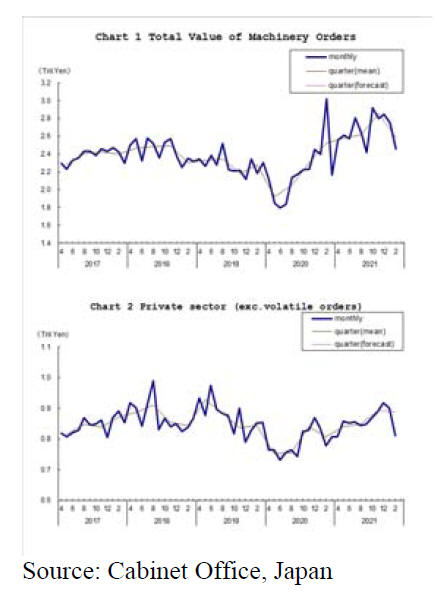
Steepest decline in consumer confidence in
two years
The March consumer confidence index released by the
Cabinet Office dropped in March and was the steepest rate
of decline in almost two years. The decline was put down
to the growing concerns on price rises and the impact of
Russia¡¯s invasion of Ukraine and how the cost of living
will likely increase.
The Cabinet Office lowered its projections of sentiment
for the third consecutive month saying consumer
confidence has been "weakening further."
See:
https://mainichi.jp/english/articles/20220408/p2g/00m/0bu/063000c
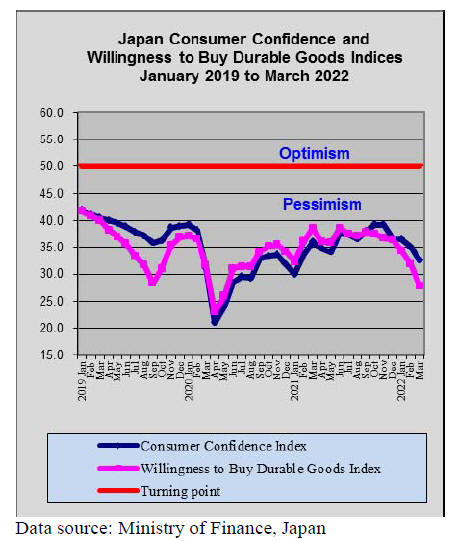
Vacant homes exceeding home seekers - should
home
loan tax relief be extended?
For Japanese seeking home loans the mortgage tax relief
system is a big advantage. Recent revisions to the overall
tax structure in Japan did not change the scale of tax relief
on home loans.
However, some analysts have raised concern that the
current structure may be ineffective and unfair.
According to the Ministry of Internal Affairs and
Communications' Housing and Land Survey in 1968 the
number of homes in Japan exceeded the number of
households to live in them. In 2018 there were about 54
million households and about 62.4 million homes. Some
are asking whether further mortgage tax breaks and
homebuilding promotion are really needed.
The government intends to extend tax relief for people
who renovate their homes. The current home renovation
tax relief will end this year but it appears it will be
extended to the end of 2023. The aim of the scheme is to
encourage sales and renovation of second hand homes as
the number of vacant properties continues to rise.
See:
https://mainichi.jp/english/articles/20220121/p2a/00m/0bu/008000c

Yen at record low
The Japanese currency fell more than 5% against the US
dollar in March despite the being seen traditionally as a
safe-haven currency in times of crisis. There was a further
decline in exchange rate in early April when the yen was
at 126 to the US dollar.
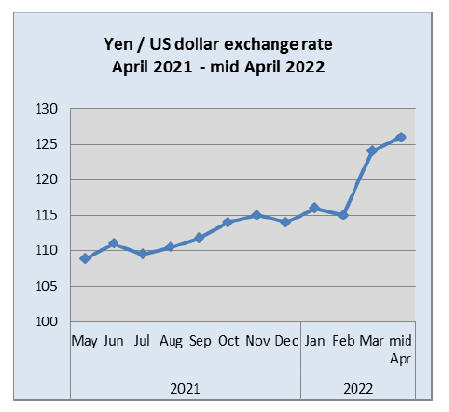
One reason for the yen¡¯s weakness is the view that
the
Bank of Japan will resist tightening monetary policy in
contrast to other major economies. The yen weakened
against the US dollar the most of any major currency
except the ruble during the first quarter of 2022.
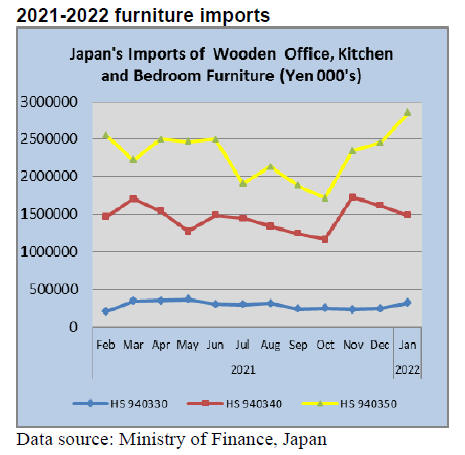
January office furniture imports (HS 940330)
The top shipper of wooden office furniture in January
2022 was China and it increased its share of imports by
Japan to 83%, up from the 75% in December 2021. The
other main suppliers in January were the US (5%. Down
from a month earlier) and Poland (2%, also down from a
month earlier.
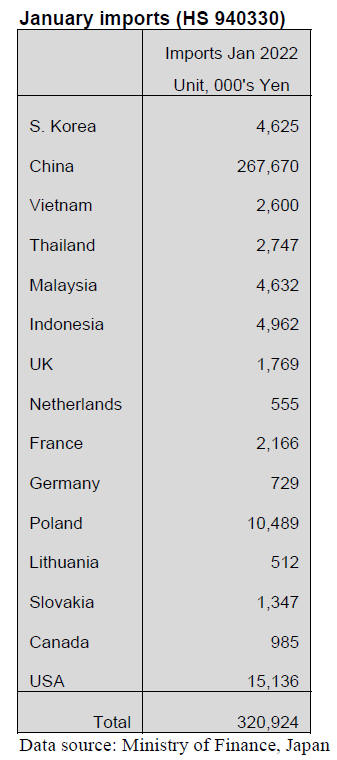
Year on year the value of imports of wooden office
furniture (HS940330) rose a massive 42% in January 2022
continuing the upward trend seen at the end of last year.
Month on month the value of wooden office furniture
imports rose 29%. Clesarly importers were anticipating an
upswing in demad in Japan as the covid infection rates had
started to decline.
January kitchen furniture imports (HS 940340)
Following a very sharp rise in the value of wooden kitchen
furniture in November 2021 there was a 6% downward
correction in December and this downward correction
extended into January 2022. After the rise in wooden
kitchen furniture from the Philippines in December there
was a downward correction of 39% in January.
On the other hand the other two main suppliers, Vietnam
and China, saw their share of imports rise in January.
Imports from Vietnam rose 36% and imports from China
were up 13%. Year on year January 2022 the value of
wooden kitchen furniture imports rose 10% but were down
8% compared to a month earlier.
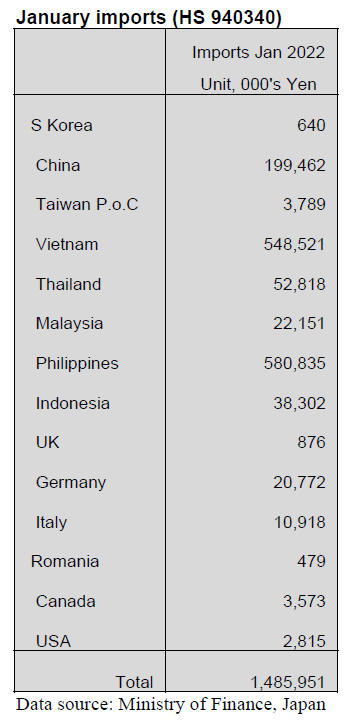
Janauary bedroom furniture imports (HS
940350)
The top suppliers of wooden bedroom furniture in January
2022 were China (61%) and Vietnam (30%). The value of
shipments from both countries was over 20% higher than
in December 2021. In January 2022 shipments of wooden
bedroom furniture from Malaysia fell by around 30% but
arivals from Poland were higher in January compared to a
month earlier. Year on year, January 2022 imports were
8% higher and month on month January imports were 16%
higher.
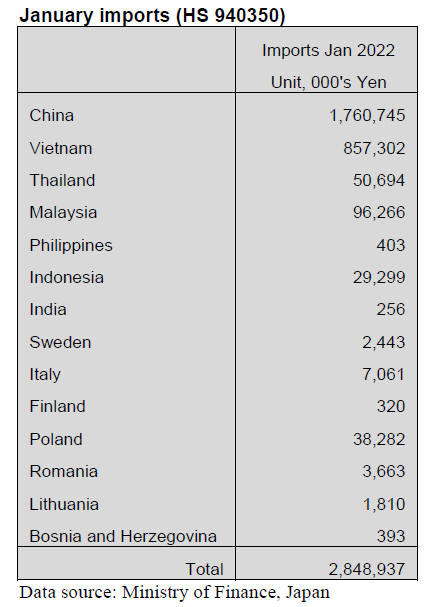
Trade news from the Japan Lumber Reports (JLR)
The Japan Lumber Reports (JLR), a subscription trade
journal published every two weeks in English, is
generously allowing the ITTO Tropical Timber Market
Report to reproduce news on the Japanese market
precisely as it appears in the JLR.
For the JLR report please see:
https://jfpj.jp/japan_lumber_reports/
Impact of export ban of Russian veneer
The Russian government announced to stop exporting
Russian made veneer and wood chip on March 10. This is
a big blow to the Japanese softwood plywood
manufacturers and they are hurriedly look for the
substitution but it seems a long shot to find immediate
substitution with sizable volume.
If they try to use domestic cedar logs to manufacture
veneer it would push log prices further up when log supply
has been tight in competition with sawmills and laminated
lumber mills. They normally carry about a month
inventory of Russian veneer but because of confusion of
shipping, the supply of veneer has been tight since last
year and the inventory on hand will be gone by the end of
this month.
By disruption of Russian veneer supply total plywood
production would drop by about 20% or 20-30,000 cbms a
month. The shipment has been exceeding the production
and the inventory of softwood plywood at the end of
January was only 77,000 cbms, only 0.3 month so if the
production decreases 20 -30,000 cbms a month, supply of
softwood plywood would get worse.
Annual import of Russian larch veneer is about 250,00
cbms. It is equivalent to one million sheets of 12 mm thick
3x6 plywood. It is volume more than one large plywood
mill.
Substituting supply with South Sea hardwood plywood has
been low because of log shortage in producing regions and
volume of Chinese plywood is limited. Structural
particleboard and MDF have no extra supply volume since
regular customers¡¯ requirement is full. OSB supply from
the U.S.A. and Europe has no surplus volume for Japan
with active demand.
There is no extra capacity to produce and dry veneer by
domestic manufacturers to replace imported veneer even if
log supply is secured so it is unavoidable to see decrease
supply of plywood.
The largest plywood manufacturing group, Seihoku
consumes about 18,000 cbms of Russian larch veneer,
which are used for face and back of structural plywood
together with North American Douglas fir and domestic
larch. Now that supply of Russian veneer stops, Seihoku
proposes customers 100% domestic cedar plywood.
Keytec, LVL manufacturer, uses Russian veneer for high
strength structural LVL for both residential and
nonresidential buildings. Demand of 140 E LVL has been
established and it can be manufactured with North
American Douglas fir, New Zealand radiate pine and
domestic larch. It is consulting with the customers to use
substituting materials.
Candidates of substituting species are North American
Douglas fir, New Zealand Radiata pine, Australian and
Brazilian eucalyptus and domestic larch.
Russian veneer production by Japanese investment
There are two major companies which manufacture veneer
in Russia. One is Terneiles, Plastan, Primorski Krai, which
is Sumitomo Trading¡¯s joint venture company. Another is
RFP in Khabarovsk Krai, which is capital participation by
the Iida Group Holdings.
Both produce larch veneer about 440,000 cbms a year out
of which 275,000 cbms has been shipped for Japan and
other volume is exported to Korea and China. Despite
export ban of veneer for Japan by the Russian government
both are determined to continue full production of veneer
and plan to export more for Korea and China.
Weak yen pushes import cost
Trend of depreciation of the yen continues. The yen rate to
the dollar in early March was 115 yen then it dropped
down to 125 yen now. This is negative factor to push the
cost of imported products while it helps promote export
business.
Distributors are reluctant to commit future contracts as
they are surely higher in cost in the yen compared to what
they are holding in inventory.
Second quarter contracts for North American Douglas
fir
and hemlock square are concluded in February but
negotiations on SPF lumber and Douglas fir taruki
continue. Some suppliers of Douglas fir taruki settled a
tUS$915-920 per cbm C&F,US $90 drop from previous
prices.
When this offer was made, the exchange rate was 115 yen
per dollar and import cost would be almost 112,00 yen per
cbm FOB truck port yard, 7,000 yen lower than previous
contract cost but with exchange rate of 120 yen the cost
would be about 117,000 yen. Unless the suppliers reduce
the prices more than US$70 the yen cost would not drop.
When the North American lumber market is booming, it
does not make sense for the suppliers to reduce export
prices.
Canadian SPF lumber¡¯s proposed prices are US$1,450 -
1,500 per MBM C&F,US $250-300 higher than previous
prices. At the beginning of the negotiation, the yen¡¯s
exchange rate was 115 yen per dollar. Imported cost
would be 117,000-121,000 yen per cbm FOB truck port
yard, 21,000-25,000 yen up, which is steep increase equals
to the wood shock prices but with exchange rate of 120
yen, the cost would be 122,000-126,000 yen, increase of
26,000-30,000 yen, 5,000 yen more than 115 yen rate.
Imported lumber inventory at the Tokyo harbor at the end
of February was high with 175,000 cbms. Since future
import cost would be higher by weak yen only measure
the dealers have is to hold the inventory.
Plywood
Japanese manufacturers are cautious of an effect on
domestic softwood plywood in Japan by an invasion of
Ukraine by Russia. There will be no imported veneer from
Russia after April.
Some plywood manufacturers say that they could produce
plywood even though they did not have enough inventory
since last half of the year so the affect will not be a long
time at this time.
On the other hand, some other manufacturers are worried
about production would be reduced by 20%. Precutting
manufacturers have still orders from housing companies to
work in April, so there is a possibility to be a shortage of
plywood.
There is another problem of cost for raw materials. It is
difficult to buy enough logs in Japan. The imported
Douglas fir logs are still high-priced and supply volume is
very limited.
Russia banned exporting veneer to Japan, so it affects
plywood prices in Japan. The price of oil and natural
gas are soaring by an invasion of Ukraine by Russia.
Glue and distribution cost will also increase.
The price of imported South Sea hardwood plywood is
unable to decrease because of the selling prices for foreign
countries are high and a weak yen pushes landed cost.
All kinds of South Sea hardwood plywood are not enough
in Japan.
However, trading companies say that it is hard to order
specific kind of plywood because there are not enough
labor and logs for local manufacturers. Therefore, some
plywood manufacturers in South East Asia say that they
understand about a weak yen but they cannot stop raising
their prices due to a price increase of cost.
A price hike of domestic softwood plywood
Plywood manufacturers in Eastern and Western Japan
decided to raise the price of plywood after April 1. The
price of 12mm of 3 x 6 will be 1,800 yen (per sheet) and
this is 100 yen up from March. It is going to be 90,000 yen
as per cbm and this is 5,000 yen up from March.
The plywood manufacturers need to raise the prices
because of a price hike of domestic and imported logs and
glue. They are concerned about raising the prices again by
prohibited exporting veneer from Russia and soared
natural resources.
24mm of 3 x 6 costs 3,600 yen and this is 200 yen more
than the previous month. 28mm of 3 x 6 costs 4,200 yen
and this is 250 yen more than the previous month.
The prices of logs have been increasing in Japan. Cedar
logs for plywood in Tohoku area is 15,000 yen to 17,000
yen (per cbm). It is 2,000 yen higher than last month.
Larch logs cost 27,000 yen (per cbm). The prices continue
rising definitely in the future. In Western Japan, cedar logs
for plywood are 15,000 yen (per cbm). The price hike will
happen because the exporting to China is very active.
Demand in Japan is firm while production cost is
increasing. Precutting manufacturers still have orders from
units built for sale companies so they are busy in March
and April.
A wholesalers says that it is hard to buy a large amount of
plywood because there will be very lively at construction
of wooden structures after April. An invasion of Ukraine
by Russia will cause a bad influence to domestic plywood.
There is not a big influence by banned exporting veneer
from Russia yet.
However, Japanese larch is very high cost and a tight
supply of Douglas fir so the price hike will occur after
April. Some glue companies in Japan had already asked
the plywood manufacturers about their price hike due to
the prices of oil and natural gas increasing.
|